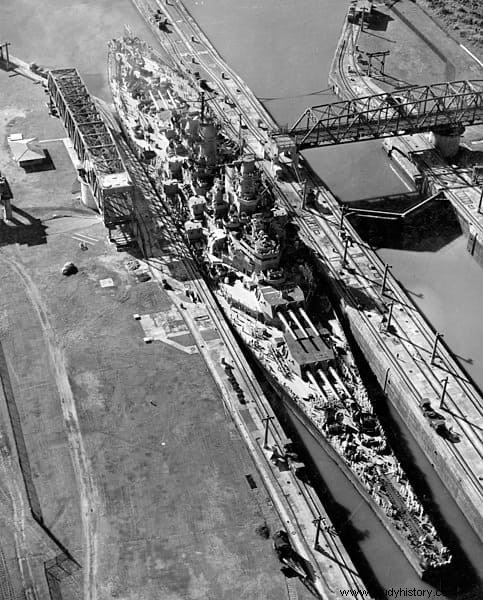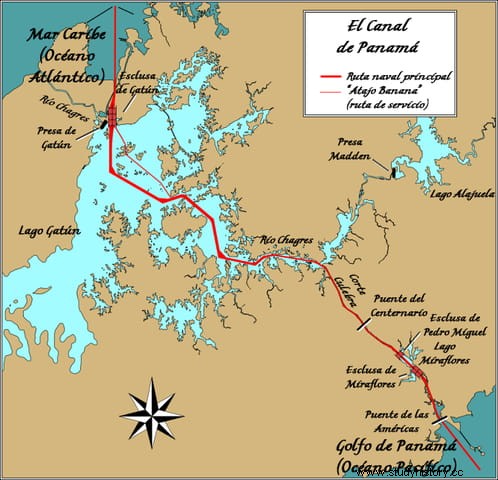Sometimes it seems that the Nazi regime had a plan for absolutely everything, since three quarters of a century after the end of World War II, some unpublished are still being found. A good example would be the one that was revealed in mid-2017 in Chile, which would have the objective of attacking the Panama Canal to hinder US maritime communications.
The information comes from the archives of the PDI (Investigative Police) of Chile, declassified after the demand of a group of deputies to clarify the degree of collaboration that there was then on the part of political, social and economic classes with Hitler's Germany. As is known, South America exerted a certain attraction on the Nazis in several aspects and although the best known part of it is the refuge that some countries gave to various war criminals after the victory of the Allies, another somewhat darker episode constitute the operations of German spies in such latitudes.
Indeed, at the end of the 1930s the presence of these agents was discovered on Chilean soil - it was later learned that they had been there for eight years - dedicated to noting the movements of ships and troops through the Strait of Magellan, since they had their center in the Valparaiso city. In addition, they spread propaganda and organized paramilitary training for young people of Teutonic descent (there was a significant German emigration to Chile at the beginning of the 20th century). They even intercepted the radio communications of the Chilean navy.

For this reason, the government of Santiago created a special unit called Department 50 (because of the telephone prefix they used at their headquarters), whose mission was to search for and arrest them. This body began operating in 1939 with twenty-two men and managed to dismantle many of these activities, locating two networks and seizing weapons, abundant ammunition, code books, thousands of dollars in cash and a transmission station. The main arrested ringleader turned out to be Bernardo Timmermann, a photographer who fell along with his three assistants and some forty collaborators. The success of that unit was recognized by Edgar Hoover himself, director of the FBI, from whom a letter of congratulations is preserved.
That document is just one more among the thousand that in ten bound volumes and corresponding to about eighty files that outline the investigation processes, witness statements, photographs and others, that were part of the PDI archives (to which it depended). the Department 50 ) now declassified, sent to the National Archives, digitized and brought to light for consultation and public download from the official website. They cover a period from 1937 to 1944 and their authenticity has been endorsed by the director of the archive.
Among the material seized by Department 50 There were various plans. One envisioned dynamiting the mines in the north of the country to cut off ore exports to the Allies. But probably the most surprising, ambitious and daring was the one that intended to attack the Panama Canal, as explained by the director of the PDI, although he did not reveal the details of the operation. Obviously, blowing up the canal gates would have put it out of use for quite some time, with the consequent negative effect on the interoceanic navigation of the US fleet, which, let us remember, had to serve one front in the Atlantic and another in the Pacific. 
In fact, another plan was already known, this official one, to bomb such a strategic site in 1943 with two Stuka planes. JU-87 that would be taken disassembled to Colombia in submarines to reassemble them there and make a raid on the Gatun Dam (which is in the western part); then the pilots would land in a neutral country, assuming they would be interned there until the end of the war. It was baptized with the name of Pelikan Operation or Projekt 14 but it was never carried out without the reasons being known, presumably because of a suspected leak.
What is more, the Japanese also included the canal among their objectives and designed plans to attack it, in their case using submarines, although the course of the war, increasingly adverse for Japan, diluted that possibility by moving the theater of operations away from American soil progressively. Just in case, the US had allocated 67,000 men for its protection, spread over 134 points along the isthmus, as well as powerful coastal and anti-aircraft artillery.
It is curious that all this has been revealed just the same week in which a small treasure made up of Nazi relics was discovered and hidden behind a shelf in the house of a collector in Buenos Aires:some seventy-five varied pieces between medals, daggers, busts , photographic negatives, musical instruments, toys, medical supplies and even Hitler's personal magnifying glass, which show that the Nazi plot in South America can still continue to hold surprises.
